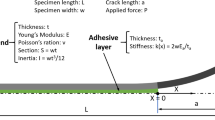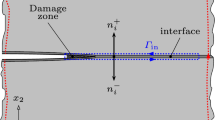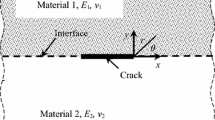Abstract
Strain-rate effects on the deflection/penetration behaviors of a crack terminating perpendicular to a linear elastic bimaterial interface under dynamic tensile loadings are investigated numerically with the so-called Cohesive Crack Model and quasistatic material parameters. The competition between the deflection and the penetration is found to depend markedly on the loading rate (or the strain rate) and amplitude as well as the interfacial strength. The crack can penetrate through the interface only when the strain-rate is higher than a threshold value (or the critical strain-rate) which decreases with the interfacial strength, or else the crack will deflect into and then propagate along the interface; the minimum loading amplitude needed for the crack penetration increases with the strain-rate, and, startlingly, such a strain-rate dependence is found to be independent of the interfacial strength. Furthermore, two inferences can be drawn directly: one is that the second phase failure in composite materials or concrete can occur at high strain-rate, which has been observed experimentally by previous authors (Brara and Klepaczko in Int J Impact Eng 34:424–435, 2007); the other is that the strain-rate effects of the dynamic failure strength of composite and concrete can be induced only by the structural response of materials, which sustains the argument proposed by Cotsovos and Pavlović (Int J Impact Eng 35:319–335, 2008).
Similar content being viewed by others
References
Arias I, Knap J, Chalivendra VB, Hong S, Ortiz M, Rosakis AJ (2007) Numerical modeling and experimental validation of dynamic fracture events along weak planes. Comput Methods Appl Mech Eng 196: 3833–3840
Bogy DB (1971) On the plane elastostatic problem of a loaded crack terminating at a material interface. J Appl Mech 38: 911–918
Brara A, Klepaczko JR (2007) Fracture energy of concrete at high loading rates in tension. Int J Impact Eng 34: 424–435
Buyukozturk O, Hearing B (1998) Crack propagation in concrete composites influenced by interface fracture parameters. Int J Solids Struct 35: 4055–4066
Camacho GT, Ortiz M (1996) Computational modeling of impact damage in brittle materials. Int J Solids Struct 33: 2899–2938
Chalivendra VB, Rosakis AJ (2008) Interaction of dynamic mode-I cracks with inclined interfaces. Eng Fract Mech 75: 2385–2397
Chandra N, Li H, Shet C, Ghonem H (2002) Some issues in the application of cohesive zone models for metal-ceramic interfaces. Int J Solids Struct 39: 2827–2855
Cook TS, Erdogan F (1972) Stresses in bonded materials with a crack perpendicular to the interface. Int J Eng Sci 10: 677–697
Cotsovos DM, Pavlović MN (2008) Numerical investigation of concrete subjected to high rates of uniaxial tensile loading. Int J Impact Eng 35: 319–335
Cudré-Mauroux N, Kausch HH, Cantwell WJ, Roulin-Moloney AC (1991) High speed crack propagation in bi-phase materials: an experimental study. Int J Fract 50: 67–77
Geubelle PH, Baylor J (1998) Impact-induced delamination of laminated composites: a 2D simulation. Compos Part B 29: 589–602
He MY, Hutchinson JW (1989) Crack deflection at an interface between dissimilar elastic materials. Int J Solids Struct 25: 1053–1067
Klein PA, Foulk JW, Chen EP, Wimmer, SA, Gao H (2000) Physics-based modeling of brittle fracture: cohesive formulations and the application of meshfree methods. Sandia National Laboratory, Technical Report, SAND2001-8099
Lei J, Wang YS, Gross D (2008) Numerical simulation of crack deflection and penetration at an interface in a bi-material under dynamic loading by time-domain boundary element method. Int J Fract 149: 11–30
Li R, Chudnovsky A (1993) Variation of the energy release rate as a crack approaches and passes through an elastic inclusion. Int J Fract 59: R69–R74
Meguid SA, Tan M, Zhu ZH (1995) Analysis of cracks perpendicular to bimaterial interfaces using a novel finite element. Int J Fract 73: 1–23
Rice JR (1968) Mathematical analysis in the mechanics of fracture. In: Liebowitz H (ed) Fracture, vol 2. Academic Press, New York
Siegmund T, Fleck NA, Needleman A (1997) Dynamic crack growth across an interface. Int J Fract 85: 381–402
Tan MG, Meguid SA (1996) Dynamic analysis of cracks perpendicular to bimaterial interfaces using a new singular finite element. Finite Elem Anal Des 22: 69–83
Wijeyewickrema AC, Dundurs J, Keer LM (1995) The singular stress field of a crack terminating at a frictional interface between two materials. J Appl Mech 62: 289–293
Xu X-P, Needleman A (1994) Numerical simulations of fast crack growth in brittle solids. J Mech Phys Solids 42: 1397–1434
Xu X-P, Needleman A (1996) Numerical simulations of dynamic crack growth along an interface. Int J Fract 74: 289–324
Xu LR, Huang YY, Rosakis AJ (2003) Dynamic crack deflection and penetration at interface in homogenous materials: experimental studies and model predictions. J Mech Phys Solids 51: 461–486
Zak AR, Williams ML (1963) Crack point stress singularities at a bi-material interface. J Appl Mech 30: 142–143
Zavattieri PD, Espinosa HD (2001) Grain level analysis of crack initiation and propagation in brittle materials. Acta Mater 49: 4291–4311
Zhang W, Deng X (2007) Elastic fields around the cohesive zone of a mode III crack perpendicular to a bimaterial interface. J Appl Mech 74: 1049–1052
Zhang Z-Y, Paulino GH (2005) Cohesive zone modeling of dynamic failure in homogeneous and functionally graded materials. Int J Plast 21: 1195–1254
Author information
Authors and Affiliations
Corresponding author
Rights and permissions
About this article
Cite this article
Liu, L.G., Ou, Z.C., Duan, Z.P. et al. Strain-rate effects on deflection/penetration of crack terminating perpendicular to bimaterial interface under dynamic loadings. Int J Fract 167, 135–145 (2011). https://doi.org/10.1007/s10704-010-9533-2
Received:
Accepted:
Published:
Issue Date:
DOI: https://doi.org/10.1007/s10704-010-9533-2




